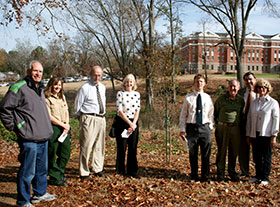
Lander University observed Arbor Day last week with a dedication ceremony for a very special tree.
The tree, planted last month near the pedestrian bridge behind Centennial Hall, sprouted from an acorn dropped by the Treaty Oak, a 500-year-old live oak in Austin, Texas. The Treaty Oak is the last surviving member of the Council Oaks, a grove of 14 trees revered by the Comanche and Tonkawa Indians as a sacred gathering site. It was donated by Greenwood horticulturalist John Elsley and his wife, Billie, a native of Texas.
The Treaty Oak was poisoned in 1989, in an act of deliberate vandalism. The massive tree lost much of its foliage, and it was eight years before it had recovered sufficiently to produce another crop of nuts.
Today, many Texans regard the Treaty Oak as a symbol of strength.
At one time, live oaks furnished wood for the ships of the British Empire, according to Lander assistant professor of biology Dr. Austin Trousdale, who spoke at the Arbor Day ceremony.
Live oaks were prized by the American colonists, said Trousdale, adding that the nation's first tree farm was established by President John Quincy Adams to ensure a supply of the wood.
Trousdale called the live oak "synonymous with the Deep South."
Several large trees have been removed in recent years from the hillside where the seedling from the Treaty Oak was planted. Dr. DeWitt Stone, chair of Lander's arboretum committee, said that committee members wanted to spruce up "a scrubby part of the campus," and they wanted to do it with "native, natural trees."
The area can be seen from Lander's dining hall windows. With time, Stone said, the live oak, bald cypress, black willows and other indigenous trees recently added to the landscape should greatly improve the view.
He cited the examples of the hillside above the president's home, once a tangle of wisteria and ivy, as well as the Lander Shade Garden, formerly an eyesore, as examples of what time and a vision of the future can do.